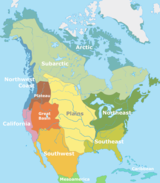Indigenous peoples of the Great Basin


The Indigenous peoples of the Great Basin are
Great Basin peoples
- Fremont culture (400 CE–1300 CE), Utah[2]: 161
- Kawaiisu, southern inland California[3]
- Timbisha or Panamint or Koso, southeastern California
- Washo, Nevada and California[4]
- Palagewan
- Pahkanapil
Northern Paiute
- Northern Paiute, eastern California, Nevada, Oregon, southwestern Idaho[3]
- Kucadikadi, Mono Lake Paiute, California
- Bannock, Idaho[3]
Mono
- Mono, southeastern California
- Eastern Mono (Owens Valley Paiute), southeastern California
- Western Mono, southeastern California
Southern Paiute
- Southern Paiute, Arizona, Nevada, Utah[5]
- Chemehuevi, southeastern California
- Kaibab, northwestern Arizona
- Kaiparowits, southwestern Utah
- Moapa, southern Nevada
- Panaca
- Panguitch, Utah
- Paranigets, southern Nevada
- Shivwits, southwestern Utah
Shoshone
- Eastern Shoshone people:
- Mountain Sheep Eaters, joined the Northern Shoshone[7]
- Northern Shoshone people:
- Western Shoshone people:
- Gosiute), Great Salt Desert and Great Salt Lake, Utah[10]
- Bitterroot Eaters, Halleck, Mary's River, Clover Valley, Smith Creek Valley, Nevada[10]
- Mentzelia Seed Eaters, Ruby Valley, Nevada[10]
- Fish Eaters, Cache Valley, Idaho and Utah[10]
- Deep Creek Gosiute, Deep Creek Valley, Antelope Valley[10]
- Pinenut Eaters, northernmost band[10]
- Railroad Valley, Nevada[10]
- Tsogwiyuyugi, Elko, Nevada[10]
- Ricegrass Eaters, Ione Valley, Nevada[10]
- Ryegrass Seed Eaters, Ruby Valley, Nevada[10]
- Buffalo Berry Eaters[10]
Ute
- Northern Ute
- San Pitch, central Utah
- Seuvarits, Moah Utah area
- Timpanogos, north central Utah
- Uncompahgre (Tabeguache), central and northern Colorado
- Uintah
- White River Utes, Colorado and eastern Utah
- Parianuche, along Colorado River valley in central and western Colorado
- Sabuagana, along Colorado River valley in central and western Colorado
- Yampa
- Southern Ute
- Ute Mountain
- Weeminuche, western Colorado, eastern Utah, northwestern New Mexico
- Absorbed by the Paiute Indian Tribe of Utah
- Moanunts, Salina, Utah
- Pahvant, western Utah
History
The oldest known petroglyphs in North America are in the Great Basin. Near the banks of Winnemucca Lake in Nevada, this rock art dates between 10,500 and 14,800 years ago.[11]
Archaeologists called the local period 9,000 BCE to 400 CE the Great Basin Desert Archaic Period. This was followed by the time of the
The first Europeans to reach the area was the Spanish
Because their contact with European-Americans and African-Americans occurred comparatively late, Great Basin tribes maintain their religion and culture and were leading proponents of 19th century cultural and religious renewals. Two
In 1930, the
Conditions for the Native American population of the Great Basin were erratic throughout the 20th century. Economic improvement emerged as a result of President
Today
Cultures

Different ethnic groups of Great Basin tribes share certain common cultural elements that distinguish them from surrounding groups. All but the
"Desert Archaic" or more simply "The Desert Culture" refers to the culture of the Great Basin tribes. This culture is characterized by the need for mobility to take advantage of seasonally available food supplies. The use of
In the early historical period the Great Basin tribes were actively expanding to the north and east, where they developed a horse-riding bison-hunting culture. These people, including the Bannock and Eastern Shoshone share traits with Plains Indians.
Today, the Great Basin Native Artists, which was cofounded by Melissa Melero-Moose represents Indigenous visual artists from the region and curates groups exhibitions.[13]
Notes
- .
- ^ ISBN 978-0-16-004581-3.
- ^ a b c D'Azevedo ix
- ^ Nicholas, Walter S. "A Short History of Johnsondale". RRanch.org. Archived from the original on 2010-10-31. Retrieved 2010-06-04.
- ^ Pritzker 230
- ^ a b c Loether, Christopher. "Shoshones." Encyclopedia of the Great Plains. Retrieved 20 Oct 2013.
- ^ a b c Shimkin 335
- ^ a b c d e f Murphy and Murphy 306
- ^ a b c Murphy and Murphy 287
- ^ a b c d e f g h i j k l m n Thomas, Pendleton, and Cappannari 280–283
- ^ Than, Ker (15 August 2013). "Oldest North American Rock Art May Be 14,800 Years Old". National Geographic. Archived from the original on March 12, 2020. Retrieved 3 July 2020.
- ^ a b c d e "History Timeline of Great Basin National Heritage Area." Archived 2013-06-22 at the Wayback Machine Great Basin National Heritage Area. Retrieved 24 June 2013.
- ^ "Melissa Melero-Moose". School for Advanced Research. 2015.
External links
- Great Basin Native Artists, a collective of indigenous artists from the Great Basin
- Great Basin artwork in Infinity of Nations, National Museum of the American Indian

